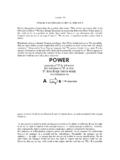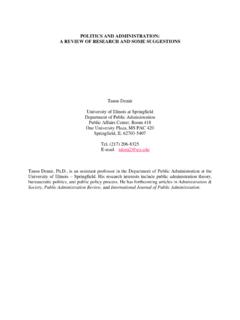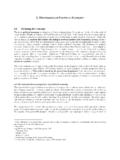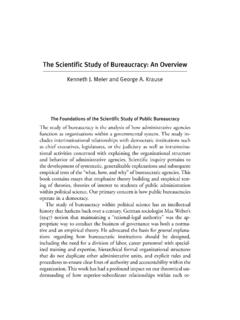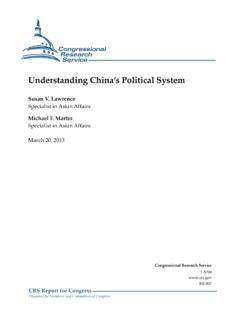Transcription of PublicPolicy101’ What’ispolicy?’’
1 Public Policy 101 what is policy? Policy is everywhere. It controls what we buy, where, what we eat, how much we pay, transportation, the environment, Its application and effect demonstrate what makes policy so important. Policy is about the people. Policy outlines our socially accepted norms and practices to assure some form of predictability in the allocation of scarce resources so we can all contribute towards a social outcome. Examples demonstrate how wide- ranging policy can be: - A lacrosse league sets out rules and regulations regarding return to play procedures for athletes following a concussion.
2 - A school sets a dress code - A government increases the tax on sugary drinks - A parent establishes what is acceptable behavior at the dinner table Note that only one of these involves a formal government structure. Policy can be defined in many ways depending on its application. An overarching definition can be defined as follows: Policy: a course or principle of action adopted or proposed by a government, party, business, or individual. Origin: Late Middle English: from Old French policie civil administration, via Latin from Greekpoliteia citizenship, from polit s citizen, from polis city.
3 From there we can rely on Dean Kilpatrick, from his work Definitions of Public Policy and the Law to define Public Policy as: Public policy can be generally defined as a system of laws, regulatory measures, courses of action, and funding priorities concerning a given topic promulgated by a governmental entity or its representatives. A Classification of Classifications of Policy Many- a- day have been spent assigning labels or classifications to policy. Generally policies can be broken down into personal, organizational and public each reflecting the realms of jurisdiction to which they apply.
4 This paper will focus on Public Policy. Each policy is unique and deserves interpretation of implications rather than strict classification. A good example of this is with cigarettes. The evolution of cigarette/tobacco policy is a great example of the dynamic roles that policy can take. Beyond the health impact of cigarettes, cigarette taxes as the argument goes cost society money. Increase in taxes on cigarettes, decreases use and leads to more individuals reaching older age that has higher healthcare costs. These additional costs are greater than the generated revenue, not to mention the time lapse between income and expenditure that is well beyond a political lifespan.
5 Obviously, cost is not the only consideration with cigarette taxes, the social implications outweigh the financial considerations. The point is that policy is not always straight forward and classification is often misleading. Cigarette policy has many elements than span classifications (reactive and proactive, substantive and administrative, regulatory, redistributive, current and future, etc.). Reactive and Proactive Refers to the timeline that the policy is being applied. Cigarette taxes in response to health concerns is reactive. A child fitness tax credit to prevent obesity rates is proactive. Substantive and Administrative Substantive refers to legislation or programs that affect the significant or substantive aspects of community work while administrative is the procedural or administrative aspect (such as monitoring and reporting).
6 Vertical and Horizontal Vertical refers to the traditional, formal model of policy making where by the traditional body (government) initiates, passes and imposes policy. Horizontal introduces more organizations into the development of policy (for example Public Private Partnerships P3 s). Current and Future As society changes future policy is becoming increasingly important as aspects of our society require government intervention (example of file- sharing or technology over time that was not a traditional government priority). Current aspects of policy are areas that governing bodies already have jurisdiction over.
7 Lowi Classification1 Regulatory Distributive Redistributive Regulatory: Regulation is obviously only one of several ways governments seek to control society and individual conduct. There are rather specific purposes that are 1 Lowi, Theodore J., Public Administrative Review, Vol. 32, No. 4, 1972, pp. 298- 310 Constituent best pursued through regulatory techniques, and the reading of any account of regulatory administration suggests that there is a distinct set of moral and political- process consequences associated with this kind of governmental commitment.
8 Distributive policies with many beneficiaries beyond those who pay for the program (such as farm subsidies). Redistributive Policies that reassign resources from one area to another (such as federal equalization payments). Constituent While there is some debate over Lowi s interpretation of constituent definition it may refer to the top- down process of elected officials and administrative agencies2. Public Policy v. Social Policy Social policy: will help the community much more improvement in different aspects for example some come in the following: Quality of life Education Citizenship Culture Social policy is part of public policy but public policy is more than that, it is economic policy, industrial policy, and also soial p liciy, etc.
9 Definitive answers to the supply, poverty and inequality are likely to remain elusive, and as such, it is important to sustain the opportunities for discussion, experimentation, innovation and learning in social development approaches considered3 While classification of a policy may be of note; its importance is not dependent on its classification. 2 3 The Policy Cycle: Every policy, regardless of political system, party in power, electorate, issue or idea has the same basic guidelines that outline its cycle from definition to evaluation.
10 Lasswell outlines the policy cycle as: 1. (Problem definition) Agenda setting 2. Policy formulation 3. Decision- making 4. Implementation 5. Evaluation Distracted Driving example: 1. Studies released support the assertion that texting and driving is wildly dangerous. Public concern is raised around the issue and public policy is identified as a possible solution. 2. Politicians and bureaucrats determine what policy options are available, most successful and most cost effective. 3. The legislative body votes and passes distracted driving legislation. 4. The enforcement agency (cops) enforce the policy 5. The public reflects on the policy, enforcement and implementation.



